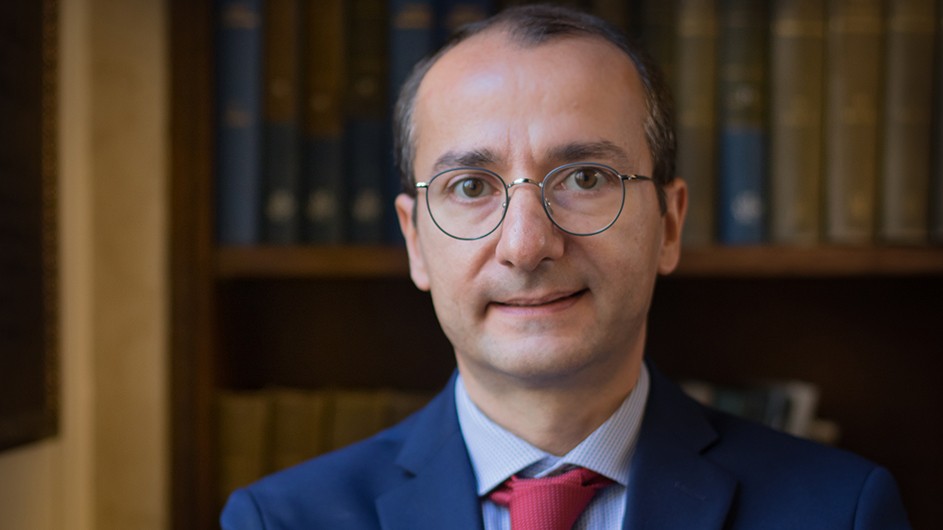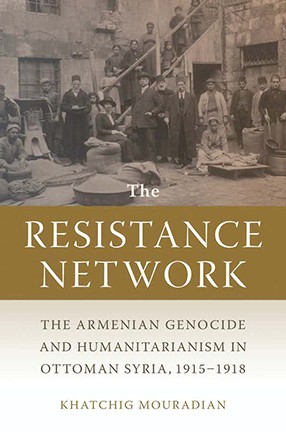Reckoning With the Armenian Genocide
Khatchig Mouradian's new book discusses the role Armenians played in organizing humanitarian resistance against the destruction of their people.

The Resistance Network, the new book by Khatchig Mouradian, a lecturer in the Department of Middle Eastern, South Asian, and African Studies, is a history of an underground network of humanitarians, missionaries, and diplomats in Ottoman Syria who helped save the lives of thousands during the Armenian genocide. Mouradian challenges depictions of Armenians as passive victims of violence and objects of Western humanitarianism, demonstrating the key role they played in organizing a resistance against the destruction of their people.
By piecing together hundreds of accounts, official documents, and missionary records, he provides a social history of resistance in wartime Aleppo and a network of transit and concentration camps. Ultimately, he argues that, despite the violent and systematic mechanisms of control and destruction in the cities, camps, and massacre sites in the region, the genocide of the Armenians did not progress unhindered—unarmed resistance proved an important factor in saving countless lives.
Mouradian discusses the book with Columbia News—including lessons that can be applied to today’s global conflicts—along with his reading recommendations and how his students are helping him during the pandemic.
Q. Why did you write this book?
A. Because I wanted to read it. I wanted to read a book depicting Armenians not just as victims being killed, or objects of Western humanitarianism being saved, but subjects who organized and led a humanitarian resistance effort. And I chose to do it by focusing on Ottoman Syria, where Armenians were sent to die of deprivation and disease, where the largest and most brutal massacres of World War I took place. If I showed the action (genocide) and the reaction (resilience and resistance). in the region referred to as “ground zero,” the Auschwitz of the Armenian genocide, the point would be made in the strongest possible way.
I weave together the stories of hundreds of survivors and resisters as they pushed back against the genocidal machine in Aleppo, Raqqa, Deir ez-Zor, and in concentration camps stretching along the lower Euphrates. In doing so, I place survivor accounts in conversation with—and sometimes in rebellion against—the scholarship and accepted wisdom on mass violence, humanitarianism, and resistance.

Q. Why have Armenians been depicted as passive victims of violence and subjects of humanitarianism as opposed to their active role during the genocide that you discuss in the book?
A. This misrepresentation is due to a combination of political realities, methodological challenges, and the inaccessibility of crucial primary sources. The Turkish state’s denial of the Armenian genocide was a major hurdle. Scholars invested significant effort into debunking arguments put forth by Turkish political elites and a handful of academics who trivialized or denied the destruction of the Armenians. In this environment, scholars focused on studying the victimization and destruction of Armenians, often ignoring the historical record on Armenian mobilization and resistance. It is as if by granting perpetrators absolute power, the case for asserting the veracity of the genocide was strengthened.
Accessing key Armenian and Ottoman sources was complicated while Western diplomatic records and missionary archives in English, German, and French were readily available. In the case of Armenian sources, language was a barrier for many scholars, Ottomanists, and comparativists alike. The genocide and the scattering of the survivors also endangered the Armenian language. Few scholars bothered to learn it. Fortunately, that trend is changing. Many up-and-coming scholars, particularly in Ottoman Studies, are learning Armenian and viewing it as integral to understanding Ottoman history.
Q. Are there any lessons learned from the bravery and actions of the Armenians that can be applied to today's crises?
A. The Armenian case demonstrates how much is suppressed from the narrative when the actions and words of the targeted groups are relegated to the margins. Every time the accomplishments of human rights organizations and humanitarian NGOs are being touted, it is a helpful exercise to ask: What about the local activists and humanitarian workers? Is their work being suppressed or erased from the narrative? And every time we read in the media about crimes and atrocities, it is worth asking: What about the agency of the victims? In what ways are they pushing back against these crimes?
The Armenian case challenges conventional thinking about mass violence, the targeted group’s reaction to it, and intervention. It demonstrates the role community structures and key connectors can play when a group is under attack, and the importance of working with them—not putting them to work—in devising and implementing any form of humanitarian action. Much of the aid work and the human rights activism we witness around the world today, well-meaning as it may be, falls short in this regard.
Q. What books do you recommend for getting through the rest of the pandemic?
A. Where the Crawdads Sing by Delia Owens, Tyll by Daniel Kehlmann, and The Red Lotus by Chris Bohjalian were among the novels that offered me escape routes out of the claustrophobia.
Heghnar Watenpaugh’s The Missing Pages took me on a journey across the globe, while Brian Greene’s Until the End of Time catapulted me to the farthest reaches of outer space, helping me appreciate “how singular and fleeting the here and now is.”
Morgan Parker’s There are More Beautiful Things than Beyoncé was one of the best poetry collections I’ve read in recent years. Her line, “My color is a bridge with no other side,” continues to haunt me.
B. What is on your reading list?
A. Min Jin Lee’s Pachinko, Debashree Mukherjee’s Bombay Hustle, A. Dirk Moses’s The Problems of Genocide, and Katie Mack’s The End of Everything are next on my list.
Q.What's your favorite book that no one else has heard of?
A. A literary gem that deserves to be widely read is Vasily Grossman’s An Armenian Sketchbook.
Q.What are you teaching this term? How are you helping your students cope with online learning?
A. I am teaching a course on internment and mass incarceration from the 19th century to the present, and another on the aftermath of mass violence. (In my defense, I also teach courses on slightly less dark subjects such as “Apologies and Non-Apologies,” “The Literature of the Great War in the Middle East,” and “Urban Space and Conflict in the Middle East”!)
I am doing my best to create an online community, foster discussion, and accommodate students as they navigate these difficult months. But, ultimately, it is the students who are helping me cope. Their resilience and continued motivation to learn and research inspire me.
Q. You're hosting a dinner party. Which three academics or scholars, dead or alive, would you invite and why?
A. I would mention people from Socrates to Edward Said, but they have been invited to plenty of dinner parties in their time and over the centuries. So perhaps I would go with University of Chicago Philosophy Professor Agnes Callard (I assign her On Anger to my apologies class), Clark University Professor Cynthia Enloe (I assign her writings on gender and militarization to my urban space and conflict course), and Royal Holloway, University of London Professor Rebecca Jinks (I assign her “Marks Hard to Erase” to my aftermaths class).
Check out Books to learn more about publications by Columbia professors.